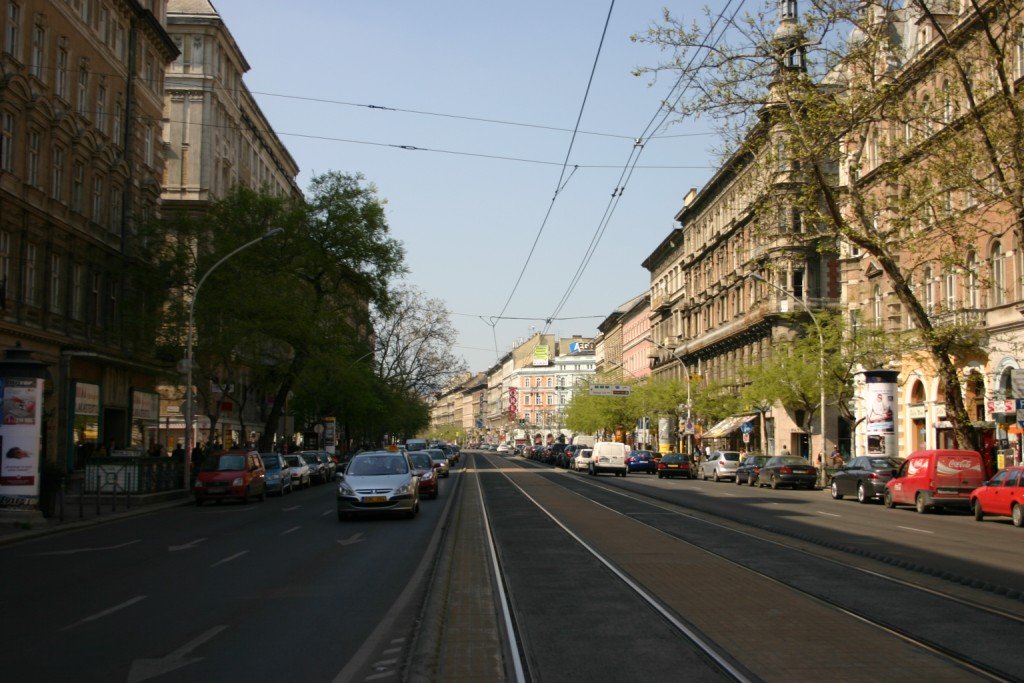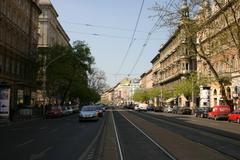
Grand Boulevard Budapest Visiting Hours, Tickets, and Attractions Guide
Date: 14/06/2025
Introduction
Budapest’s Grand Boulevard (Nagykörút) stands as a dynamic symbol of Hungary’s urban history and cultural vitality. Spanning approximately 4.1 to 4.5 kilometers through central Pest, it links Margaret Bridge in the north to Petőfi Bridge in the south, intersecting major thoroughfares like Andrássy Avenue. Conceived after the unification of Buda, Pest, and Óbuda in 1873, the boulevard was meticulously designed to serve as both a transportation artery and a showcase of Budapest’s architectural and social ambitions (Nemzeti Archívum, budapest.city). Today, it remains a vibrant corridor, blending grand architecture, historic landmarks, bustling markets, and a lively street scene, making it a must-visit for any traveler to Budapest.
Table of Contents
- Historical Background
- Visiting the Grand Boulevard: Essential Information
- Section-by-Section Guide: Key Attractions & Highlights
- Getting Around & Accessibility
- Practical Tips for Visitors
- Frequently Asked Questions (FAQ)
- Visuals, Maps, and Media
- Further Reading & References
- Conclusion and Call to Action
Historical Background
Origins and Urban Planning
The Grand Boulevard was conceived during Budapest’s rapid 19th-century growth, inspired by Parisian boulevards and Vienna’s Ringstraße. Its construction began in the 1870s, following the unification of the city’s districts. The boulevard was designed to improve transportation, connect key railway stations, and reflect the city’s modernization. Underneath runs a major sewer system, a testament to its dual role as a practical and aesthetic urban development (Nemzeti Archívum).
Architectural and Cultural Significance
The boulevard features an eclectic mix of Neo-Renaissance, Eclectic, Art Nouveau, and early modernist architecture. Notable landmarks include:
- New York Palace & Café: A Belle Époque gem and literary hub.
- Western Railway Station (Nyugati pályaudvar): Designed by Gustave Eiffel’s company.
- Vígszínház (Comedy Theatre of Budapest): A cultural mainstay since 1896.
- Madách Theatre: Home to major theatrical productions.
The Grand Boulevard has played host to pivotal moments in Hungarian history, from the city’s golden age to the 1956 Revolution, with many buildings still bearing marks from turbulent times (Daily News Hungary, Progressive Productions).
Transportation Innovations
Budapest’s first electric tram line debuted here in 1887, and today trams 4 and 6 run 24/7 along the boulevard, making it one of Europe’s busiest urban tram corridors. The Millennium Underground (M1)—Europe’s oldest continental metro—crosses the boulevard at Oktogon, further cementing its role in the city’s transportation network (Wikipedia, headout.com).
Visiting the Grand Boulevard: Essential Information
Opening and Visiting Hours
- The Boulevard: Open and accessible to pedestrians 24/7.
- Shops, Cafés, and Markets: Typically open from 8:00 or 9:00 AM to 8:00 or 10:00 PM.
- Theaters and Cultural Venues: Hours vary; most operate in the evening. Advance ticket purchase is recommended for performances.
Tickets and Entry Fees
- Walking the Boulevard: Free.
- Public Transport (Trams 4 & 6): Tickets required; single rides cost around 350 HUF. Day passes and travel cards are available.
- Attractions (e.g., theaters, museums): Tickets required; prices vary (theater tickets from 2,500 HUF/approx. 7 EUR).
Accessibility
- Pedestrian Access: Wide, paved sidewalks with frequent crosswalks.
- Public Transport: Trams 4 and 6 are low-floor and wheelchair accessible; metro stations at key intersections.
- Venues: Most modern venues are accessible. Some historic buildings may have limited wheelchair access—check ahead.
How to Get There
- Metro: Lines M1, M2, and M3 intersect the boulevard.
- Trams: Lines 4 and 6 run the full length, day and night.
- Rail: Nyugati and Keleti Railway Stations are nearby.
Section-by-Section Guide: Key Attractions & Highlights
1. Szent István körút
- Highlights: Vígszínház (Comedy Theatre), Margaret Bridge with river views.
- Tip: Best for theater lovers and scenic walks.
2. Teréz körút
- Highlights: Nyugati Railway Station (Eiffel-designed), grand cafés, and hotels.
- Tip: Ideal for history and architecture enthusiasts.
3. Erzsébet körút
- Highlights: New York Palace and Café, Madách Theatre.
- Tip: Don’t miss the ornate interiors and literary history.
4. József körút
- Highlights: Blaha Lujza Square, Corvin Department Store.
- Tip: Excellent area for shopping and people-watching.
5. Ferenc körút
- Highlights: Corvin Cinema, Great Market Hall (open Tue–Sun, 6:00 AM–5:00 PM).
- Tip: Experience authentic Hungarian markets and cinema.
Getting Around & Accessibility
- Trams 4 & 6: Run every 3–5 minutes; 24-hour service.
- Metro Intersections: Oktogon (M1), Nyugati pályaudvar (M3), Blaha Lujza tér (M2), and Corvin-negyed (M3).
- Tickets: Available at metro stations, tram stops, or via the BudapestGo app.
- Walking: Wide, well-maintained sidewalks; ideal for exploring on foot.
- Cycling: Bike lanes available along parts of the boulevard.
Practical Tips for Visitors
- Language: Hungarian is official; English widely spoken in tourist areas.
- Currency: Hungarian Forint (HUF). Credit cards widely accepted; carry cash for markets.
- Tipping: 10% is standard if not included in the bill.
- Safety: The area is generally safe; usual city precautions apply.
- Drinking Water: Tap water is safe.
- Wi-Fi: Free in many cafés and hotels.
- Season: Best visited in spring or fall for pleasant weather and festivals (headout.com).
Frequently Asked Questions (FAQ)
Q: Is the Grand Boulevard safe for tourists?
A: Yes, but remain aware of your surroundings, especially at night.
Q: How do I buy tickets for public transport and attractions?
A: Purchase at stations, tram stops, or online. Theater tickets are best bought in advance.
Q: Are there guided tours?
A: Yes, both walking and tram tours are available, often focusing on architecture or food.
Q: Is the boulevard accessible for people with disabilities?
A: Most public transport and major sidewalks are accessible; check individual venues for details.
Q: Can I use euros?
A: Some places accept euros, but HUF is recommended for most transactions.
Visuals, Maps, and Media
- Images: Include photos of New York Palace’s façade, trams 4 and 6, Western Railway Station, and bustling markets.
Alt tags: “Grand Boulevard Budapest historical sites”, “Grand Boulevard Budapest visiting hours” - Interactive Map: Official Budapest Grand Boulevard Map
- Virtual Tour: Explore Grand Boulevard Virtually
Further Reading & References
- Nemzeti Archívum
- budapest.city
- offbeatbudapest.com
- Daily News Hungary
- Wikipedia
- headout.com
- lonelyplanet.com
- Progressive Productions
Conclusion and Call to Action
The Grand Boulevard is a living testament to Budapest’s past and present—melding architectural splendor, cultural vibrancy, and cosmopolitan city life. Whether you’re marveling at Belle Époque architecture, enjoying a show, or simply riding the historic trams, the boulevard offers an immersive urban experience for every traveler.
To enrich your visit, download the BudapestGo or Audiala apps for real-time transport updates, guided audio tours, and ticketing. For more travel inspiration and insider tips, explore related articles and follow us on social media.
Start your adventure on Budapest’s Grand Boulevard today and discover the city’s timeless charm in every step!








































































































































































